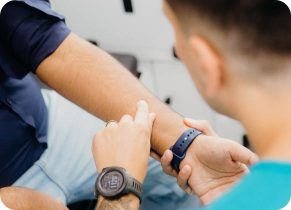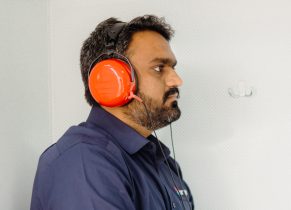Ensure the protection you provide is doing its job
Ensuring respirators and ear protection devices fit properly is crucial for protecting your workers from exposure to hazardous substances and noise-induced hearing loss.
Even when the PPE is certified for the job, certain factors such as incorrect size, comfort, the face or ear shape of the individual user, incorrect use, and inadequate training can mean respiratory masks and earplugs don’t do their job effectively,
Our health screening vans and visiting health professionals can deliver respirator fit testing and ear fit testing on-site, saving time and hassle. Alternatively, employees can come to one of our clinics.

Benefits of a respirator and ear fit testing
- Reduce risk of workers developing chronic respiratory illnesses or noise-induced hearing loss
- Verify that workers are using the proper make, model and size
- Help improve user understanding and compliance
- Lower future workers’ compensation claims
- Meet your legislative requirements
What to expect
Our highly-trained and experienced staff perform qualitative respirator and ear tests using specialised equipment. As well as carrying out the testing, we also share information on best usage with the worker.
Respirator fit test
Our specialists can test any type of tight-fitting respirator. This is important, as workers must be fit tested with the specific make, model, style, and size (full or half face) of the respirator that they’ll be using.
This respirator will have a probe attached to its face piece, which is connected to a machine by a hose. That machine, known as a Portacount™, then measures the effectiveness of the seal by measuring the amount of leakage into the face piece.
Please note: If workers wear additional PPE or prescription eyewear on the job, they should wear it during this fit test. Earmuffs, hardhats, visors or even heavy clothing can interfere with the way a respirator fits. Workers also need to be clean shaven for their fit test and any respirator use.
Workers must be fit tested before using a respirator in the workplace and then retested at least every 12 months.
Ear fit test
Our specialists carry out ear fit tests using a 3M™ E-A-Rfit™ Dual-Ear Validation System. The system helps determine whether workers are receiving adequate protection from their hearing protector by measuring across 7 standard frequencies in under five seconds.
During the test, the worker will be asked to place the small microphone probes into their ears while hearing protection. Sound pressure levels are measured inside and outside of the ear simultaneously and used to calculate PAR (personal attenuation rating) – and give a pass or fail. This method is known as MIRE (microphone in real ear)
Once every employee’s PAR is known, we can use this data to enhance your hearing conservation program.
Frequently asked questions
Here are some of the most common questions we get asked about our respirator and ear fit testing.
Who is respirator fit testing for?
Anyone who wears a respirator during their normal working day or to perform emergency response activities, should be fit tested to make sure the face piece provides an effective seal. This includes occupations such as quarry workers, coal miners, spray painters, concreters, stone masons, kitchen manufacturers, welders, and those exposed to hazardous substances such as particulate matter and fumes.
Is fit testing mandatory for all workers wearing a respirator?
Harmonised states fall under the Work Health and Safety Act 2011 and the Work Health and Safety Regulation 2011. Neither the Act nor the Regulation states fit testing as a legal requirement. However, the following guidance does:
Codes of Practice
The How to Safely Remove Asbestos Code of Practice 2011 recommends that a fit test is conducted in accordance with AS/NZS 1715:2009, ‘Selection, Use and Maintenance of Respiratory Protective Devices’.
Australian Standards
AS/NZS 1715 specifies that users of any tight-fitting masks are to be fit tested before starting work and then at least once a year.
Manufacturer Specifications
Who is ear fit testing for?
Anyone who wears ear protection during their normal working day or to perform emergency response activities should be fit tested to make sure their ear plugs piece effectively limit noise. This includes occupations such as miners, construction workers, factory workers, airport ground staff, and emergency responders.
Is fit testing mandatory for all workers wearing ear protection?
Earplug and hearing protection fit testing is now a requirement at numerous sites across industries throughout Australia. Conducted in accordance with Australian Standards AS/NZ 1269.3:2005 Occupational Noise Management, Part 3 Hearing Protector Program, it ensures the earplugs provided offer appropriate protection.
Safe Work guidelines
Safe Work states that you must provide your workers with training, information and instruction about their hearing protection, including proper use, fit and care. See the Safe Work website for more details.

















